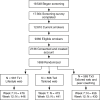A randomized trial of an avatar-hosted multiple behavior change intervention for young adult smokers
- PMID: 24395994
- PMCID: PMC3881995
- DOI: 10.1093/jncimonographs/lgt021
A randomized trial of an avatar-hosted multiple behavior change intervention for young adult smokers
Abstract
Background: Young adulthood is a critical transition period for the development of health behaviors. We present here the results of a randomized controlled trial of an online avatar-hosted personal health makeover program designed for young adult smokers.
Methods: We conducted a three-group randomized trial comparing delivery of general lifestyle content (Tx1), personally tailored health information (Tx2), and personally tailored health information plus online video-based peer coaching (Tx3) as part of a 6-week online health program. Participants were asked to set weekly goals around eating breakfast, exercise, alcohol use, and cigarette smoking. Eligibility criteria included age (18-30 years) and smoking status (any cigarette use in the previous 30 days). The primary outcome was self-reported 30-day abstinence measured 12 weeks postenrollment.
Results: Participant (n = 1698) characteristics were balanced across the groups (72% women, mean age 24, 26% nonwhite, 32% high school education or less, and 50% daily smokers). Considering intention to treat, 30-day smoking abstinence rates were statistically significantly higher in the intervention groups (Tx1 = 11%, Tx2 = 23%, Tx3 = 31%, P < .001). Participants in the intervention groups were also more likely to reduce their number of days spent on binge drinking and increase their number of days eating breakfast and exercising. Overall, intervention group participants were much more likely to make positive changes in at least three or four of the target behaviors (Tx1 = 19%, Tx2 = 39%, Tx3 = 41%, P < .001).
Conclusions: This online avatar-hosted personal health makeover "show" increased smoking abstinence and induced positive changes in multiple related health behaviors. Addition of the online video-based peer coaching further improved behavioral outcomes.
Figures
References
-
- An LC, Hennrikus DJ, Perry CL, et al. Feasibility of Internet health screening to recruit college students to an online smoking cessation intervention. Nicotine Tob Res. 2007;9(suppl 1):S11–S18 - PubMed
-
- An LC, Perry CL, Lein EB, et al. Strategies for increasing adherence to an online smoking cessation intervention for college students. Nicotine Tob Res. 2006;8(suppl 1):S7–S12 - PubMed
-
- Schneider SJ, Walter R, Odonnell R. Computerized communication as a medium for behavioral smoking cessation treatment—controlled evaluation. Comput Hum Behav. 1990;6(2):141–151
Publication types
MeSH terms
Grants and funding
LinkOut - more resources
Full Text Sources
Other Literature Sources
Medical




